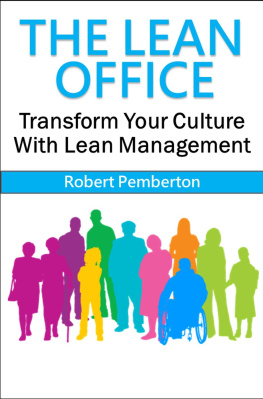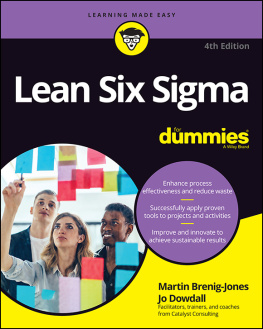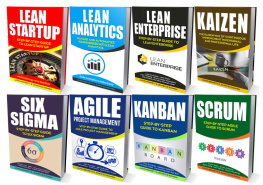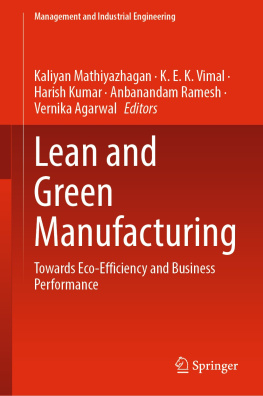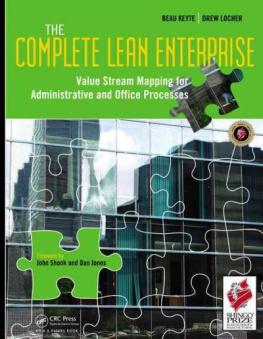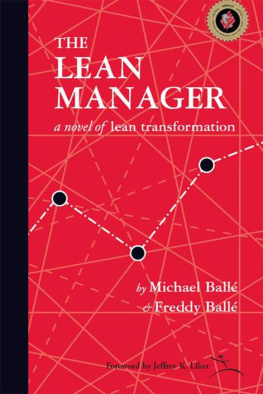
Lessons from a Lean Consultant
Avoiding Lean Implementation Failures on the Shop Floor
Chris A. Ortiz

Upper Saddle River, NJ Boston Indianapolis San Francisco
New York Toronto Montreal London Munich Paris Madrid
Capetown Sydney Tokyo Singapore Mexico City
Many of the designations used by manufacturers and sellers to distinguish their products are claimed as trademarks. Where those designations appear in this book, and the publisher was aware of a trademark claim, the designations have been printed with initial capital letters or in all capitals.
The author and publisher have taken care in the preparation of this book, but make no expressed or implied warranty of any kind and assume no responsibility for errors or omissions. No liability is assumed for incidental or consequential damages in connection with or arising out of the use of the information or programs contained herein.
The publisher offers excellent discounts on this book when ordered in quantity for bulk purchases or special sales, which may include electronic versions and/or custom covers and content particular to your business, training goals, marketing focus, and branding interests. For more information, please contact:
U.S. Corporate and Government Sales
(800) 382-3419
For sales outside the United States please contact:
International Sales
Visit us on the Web: www.informit.com/ph .
Library of Congress Cataloging-in-Publication Data
Ortiz, Chris A.
Lessons from a lean consultant : avoiding lean implementation failures on the shop floor /
Chris A. Ortiz.
p. cm.
Includes index.
ISBN 0-13-158463-4 (pbk. : alk. paper)
1. Production management. 2. Manufacturing processes. 3. Industrial efficiency. I. Title.
TS155.O772 2008
658.5dc22
2007051137
Copyright 2008 Pearson Education, Inc.
All rights reserved. Printed in the United States of America. This publication is protected by copyright, and permission must be obtained from the publisher prior to any prohibited reproduction, storage in a retrieval system, or transmission in any form or by any means, electronic, mechanical, photocopying, recording, or likewise. For information regarding permissions, write to:
Pearson Education, Inc.
Rights and Contracts Department
501 Boylston Street, Suite 900
Boston, MA 02116
Fax: (617) 671-3447
ISBN-13: 978-0-13-158463-1
ISBN-10: 0-13-158463-4
Text printed in the United States on recycled paper at Donnelley in Crawfordsville, Indiana.
First printing, March 2008
Dedication
This book is dedicated to my wife, Pavlina, and my two boys, Sebastian and Samuel, who support me in my business and writing endeavors.
Contents
Preface
By itself, implementing lean manufacturing on the factory floor will not generate the desired results unless certain systems are in place, production support staff operate efficiently, and the operators are fully engaged and committed to the change. As a lean consultant, I have traveled around the country and have seen a variety of companies and manufacturing operations. Each one was unique in its approach to lean manufacturing.
I am often asked why some companies are successful and others fail in their lean implementations. Or more simply put, what did they do to get the results they obtained?
Lessons from a Lean Consultant outlines the fundamental mistakes companies make in trying to implement lean manufacturing. I provide solutions for upper managers, engineers, and supervisors who are struggling to keep their lean implementations afloat or are looking for advice on how to mold their production operators into the powerful change agents they need to be. Lessons from a Lean Consultant helps prepare managers for working in a lean shop floor environment. Lean succeeds or fails depending on the commitment from management. Dealing with the ups and downs of lean implementations can be tough. This book shows what is expected of managers and their subordinates.
From my perspective, the lean manufacturing training and consulting business has changed over the years. It used to be common practice for companies to spend tens of thousands of dollars on individuals who taught generalized, theory-based curriculums. I am not implying that all consultants operated in this manner, but many did. This type of training and guidance has become outdated, and companies are looking for hands-on approaches to lean training.
This change in the market has affected my books on lean manufacturing. I saw this market transformation about two years ago and wrote Kaizen Assembly: Designing, Constructing, and Managing a Lean Assembly Line in an attempt to cater to the nuts-and-bolts needs of the market. Lessons from a Lean Consultant takes the same approach to lean management and culture change, providing detailed, real-life solutions to those who are struggling with workers who do not want to adapt to lean methods or adhere to the systems and procedures in place. In short, this book takes a nuts-and-bolts approach to lean management and culture transformation.
helps the manufacturing professional identify the early stumbling blocks that commonly occur during the planning and implementation of lean manufacturing in a factory environment. This chapter defines the cornerstones of the early stages of lean manufacturing: 5S, visual management, data collection, waste removal, and process design.
, explaining in detail the incentive and pay-for-skill systems that help you encourage cross-training and develop a flexible workforce.
takes a unique approach to lean leadership. This chapter emphasizes how the best leaders treat people, with or without a lean journey. In short, if company leaders manage through negative reinforcement, the organization will struggle to adapt to a lean culture.
lists and defines the key lean terms you should know.
It's my hope that professionals working in the manufacturing sector holding titles such as plant manager, engineering manager, lean manager, and even lean engineer will find value in this book. My goal is to provide a tool for creating a solid lean program in which the people in direct control of its success are driving the improvements, thereby ensuring that their implementations endure and prosper.
Acknowledgments
First and foremost, I have to give thanks to my familymy wife, Pavlina, and my two sons, Sebastian and Samuel. Without their support and encouragement, it would have been nearly impossible for me to devote the time to this book that I did. All of my professional efforts are to ensure our success together.
Second, I want to thank the staff at Prentice Hall who first took interest in this book and their professional approach to making it become a reality. I want to acknowledge my editor, Bernard Goodwin, for his passion for lean manufacturing and for taking on my project. I also have to thank Betsy Hardinger for her support in helping shape the manuscript.
The final name to mention is Debra Riffin. Debra was critical to the completion of this manuscript. I want to thank her for editing and proofreading the manuscript and helping me better convey my thoughts. Debra, you were a valuable asset.
It is important also to recognize the countless number of manufacturing professionals I have had the luxury of working with over the years. My clients are the true experts. I learn from them, and the relationships I have developed with them are critical to my company's success.
Next page

